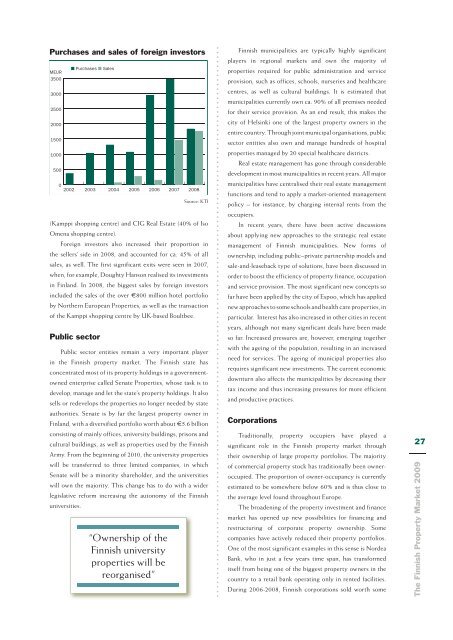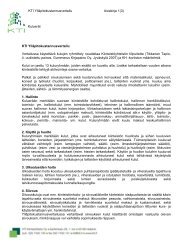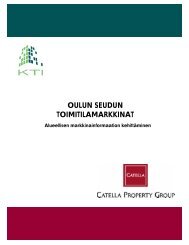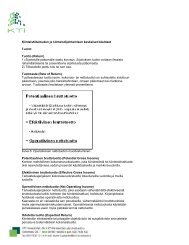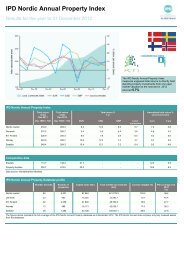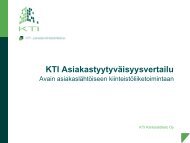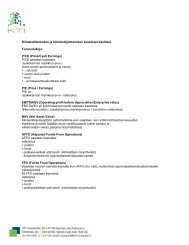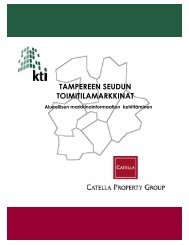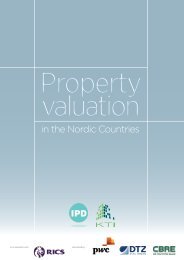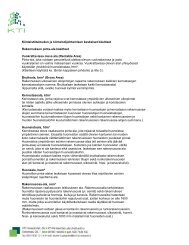The Finnish Property Market 2009 - KTI
The Finnish Property Market 2009 - KTI
The Finnish Property Market 2009 - KTI
You also want an ePaper? Increase the reach of your titles
YUMPU automatically turns print PDFs into web optimized ePapers that Google loves.
Purchases and sales of foreign investors<br />
MEUR<br />
3500<br />
3000<br />
2500<br />
2000<br />
1500<br />
1000<br />
500<br />
■ Purchases ■ Sales<br />
0<br />
2002 2003 2004 2005 2006 2007 2008<br />
(Kamppi shopping centre) and CIG Real Estate (40% of Iso<br />
Omena shopping centre).<br />
Foreign investors also increased their proportion in<br />
the sellers’ side in 2008, and accounted for ca. 45% of all<br />
sales, as well. <strong>The</strong> first significant exits were seen in 2007,<br />
when, for example, Doughty Hanson realised its investments<br />
in Finland. In 2008, the biggest sales by foreign investors<br />
included the sales of the over €800 million hotel portfolio<br />
by Northern European Properties, as well as the transaction<br />
of the Kamppi shopping centre by UK-based Boultbee.<br />
Public sector<br />
Public sector entities remain a very important player<br />
in the <strong>Finnish</strong> property market. <strong>The</strong> <strong>Finnish</strong> state has<br />
concentrated most of its property holdings in a governmentowned<br />
enterprise called Senate Properties, whose task is to<br />
develop, manage and let the state’s property holdings. It also<br />
sells or redevelops the properties no longer needed by state<br />
authorities. Senate is by far the largest property owner in<br />
Finland, with a diversified portfolio worth about €5.6 billion<br />
consisting of mainly offices, university buildings, prisons and<br />
cultural buildings, as well as properties used by the <strong>Finnish</strong><br />
Army. From the beginning of 2010, the university properties<br />
will be transferred to three limited companies, in which<br />
Senate will be a minority shareholder, and the universities<br />
will own the majority. This change has to do with a wider<br />
legislative reform increasing the autonomy of the <strong>Finnish</strong><br />
universities.<br />
“Ownership of the<br />
<strong>Finnish</strong> university<br />
properties will be<br />
reorganised”<br />
Source: <strong>KTI</strong><br />
<strong>Finnish</strong> municipalities are typically highly significant<br />
players in regional markets and own the majority of<br />
properties required for public administration and service<br />
provision, such as offices, schools, nurseries and healthcare<br />
centres, as well as cultural buildings. It is estimated that<br />
municipalities currently own ca. 90% of all premises needed<br />
for their service provision. As an end result, this makes the<br />
city of Helsinki one of the largest property owners in the<br />
entire country. Through joint municipal organisations, public<br />
sector entities also own and manage hundreds of hospital<br />
properties managed by 20 special healthcare districts.<br />
Real estate management has gone through considerable<br />
development in most municipalities in recent years. All major<br />
municipalities have centralised their real estate management<br />
functions and tend to apply a market-oriented management<br />
policy – for instance, by charging internal rents from the<br />
occupiers.<br />
In recent years, there have been active discussions<br />
about applying new approaches to the strategic real estate<br />
management of <strong>Finnish</strong> municipalities. New forms of<br />
ownership, including public–private partnership models and<br />
sale-and-leaseback type of solutions, have been discussed in<br />
order to boost the efficiency of property finance, occupation<br />
and service provision. <strong>The</strong> most significant new concepts so<br />
far have been applied by the city of Espoo, which has applied<br />
new approaches to some schools and health care properties, in<br />
particular. Interest has also increased in other cities in recent<br />
years, although not many significant deals have been made<br />
so far. Increased pressures are, however, emerging together<br />
with the ageing of the population, resulting in an increased<br />
need for services. <strong>The</strong> ageing of municipal properties also<br />
requires significant new investments. <strong>The</strong> current economic<br />
downturn also affects the municipalities by decreasing their<br />
tax income and thus increasing pressures for more efficient<br />
and productive practices.<br />
Corporations<br />
Traditionally, property occupiers have played a<br />
significant role in the <strong>Finnish</strong> property market through<br />
their ownership of large property portfolios. <strong>The</strong> majority<br />
of commercial property stock has traditionally been owneroccupied.<br />
<strong>The</strong> proportion of owner-occupancy is currently<br />
estimated to be somewhere below 60% and is thus close to<br />
the average level found throughout Europe.<br />
<strong>The</strong> broadening of the property investment and finance<br />
market has opened up new possibilities for financing and<br />
restructuring of corporate property ownership. Some<br />
companies have actively reduced their property portfolios.<br />
One of the most significant examples in this sense is Nordea<br />
Bank, who in just a few years time span, has transformed<br />
itself from being one of the biggest property owners in the<br />
country to a retail bank operating only in rented facilities.<br />
During 2006-2008, <strong>Finnish</strong> corporations sold worth some<br />
27<br />
<strong>The</strong> <strong>Finnish</strong> <strong>Property</strong> <strong>Market</strong> <strong>2009</strong>


